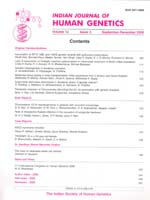
|
Indian Journal of Human Genetics
Medknow Publications on behalf of Indian Society of Human Genetics
ISSN: 0971-6866 EISSN: 1998-362x
Vol. 12, Num. 1, 2006, pp. 3-3
|
Indian Journal of Human Genetics, Vol. 12, No. 1, January-April, 2006, pp. 3
Editorial
PCR - From diagnostics to gene expression profiling
Colah RoshanB
Institute of Immunohaematology (ICMR), 13th floor, N M S Building, KEM Hospital, Parel, Mumbai - 400 012
Correspondence Address:Institute of Immunohaematology (ICMR), 13th
Floor, N M S Building, KEM Hospital, Parel, Mumbai - 400 012, colahrb@gmail.com
Code Number: hg06001
Our approach to the way we look at genes or analyse DNA completely revolutionized after Kary Mullis envisioned a means of copying DNA in a chain reaction in 1983. Subsequently, he won the Nobel Prize for inventing this powerful PCR technology which has now become a ubiquitous tool in every life science laboratory, be it for basic or applied research, for diagnostics or for teaching undergraduate students.
There are many PCR machines in the market today, starting with small
personal thermal cyclers to high throughout quantitative real time PCR
systems with improved applications like gene expression profiling, viral
load analysis, quantitation of pathogens and SNP analysis to mention
a few.
For most routine PCRs, the enzyme Taq polymerase remains the major
workhorse however, several other enzymes are available for improving
fidelity,
specificity, yield and for amplification of longer targets. Hot start
PCR systems are often useful for problematic PCR assays as well as
for multiplexing. Here, an inhibitory antibody binds the DNA polymerase
and
only when a high temperature is reached, the antibody is released which
triggers the reaction.
Inspite of all these improvements, failure of amplification still remains
a problem sometimes and requires optimization of reaction conditions
from time to time. In our experience, all target sequences do not
amplify equally well with the same polymerase. PCR inhibitors also interfere
if the nucleic acid purification is incomplete and organic solvents
remain.
RNA is more difficult to work with because it has to be first reverse
transcribed to cDNA. There are different approaches for reverse
transcriptase PCR.
A major advance has been the development of real time PCR systems
where the amount of amplicon generated is monitored and quantitated
as the
reaction progresses using fluorescent signals which increase
in proportion to the amount of PCR product accumulated in the reaction.
Different
reporter molecules like TaqMan fluorogenic probes, molecular
beacons
or the intercalating
dye SYBR Green have been used for generation of fluorescence.
In the last few years, 2 major milestones have been the development
of microarrays and RNA interference (RNAi). Real time RT-PCR
has also been
used for validation of microarray results and for confirming
the levels of gene knockdown in siRNA experiments.
In this issue of the journal, there are two articles on the
application of PCR for diagnosis of retinoblastoma and Fragile
X syndrome.
A cost effective and quick strategy of multiplex PCR has
been described for
amplification of 12 CGA codons which account for about half
of the
retinoblastoma suspectibility gene mutations. In the case
of Fragile X syndrome, the
authors have used PCR for initial screening of triplet repeat
expansions for FRAXA and FRAXE mutations with a view to cut
down the number
of cases requiring Southern blot hybridization.
Copyright 2006 - Indian Journal of Human Genetics
| 